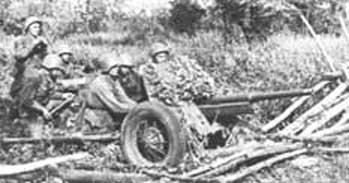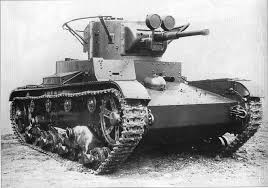By 1942, effectiveness of penetration of Soviet 45mm gun (model 1932/37) stopped being very impressive, but...* * *



* * *
Thus, project requirements were set: "Penetration of an ARMORED PLATE of 60mm, at angles of 30 degrees and up, distances at least 300-500m"
Research Institute (NII-24) answered the call developing two types of APCR shells for it:
1) 20mm Tungsten-carbide core
2) 28mm Tungsten-carbide core
Also, they manufactured same shells with Hardened steel cores as an alternative in testing! (we'll compare all of this in tests down)
* * *

45mm APCR, type 1 (20mm core), type 2 (28mm core)
* * *
THEORY and TESTINGIn theory they met the requirements (penetration at 30 degrees angle):
| 0 meters: 80 mm |
| 100 meters: 74 mm |
| 200 meters: 69 mm |
| 300 meters: 65 mm |
| 400 meters: 60 mm | | |
| 500 meters: 56 mm |
| 600 meters: 52 mm |
| 700 meters: 48 mm |
| 800 meters: 44 mm |
| 900 meters: 40 mm |
| 1000 meters: 37 mm |
Many
practical tests were done, here are some exceptions (
all done at 30 degrees angle!, except stated otherwise!):
| "Armour 50 mm, cemented, distance 120m, Shell type - 1 (20mm core), Core type - STEEL" |
Result #1: Dent
[3-6mm deep dent inside armour, core is stuck in the armor]
Result #2: Penetration [
diameter of the entrance 60-80 mm, 30-45 mm exit. core is destroyed. The plywood behind the target has a breach 150x100 mm]
Changing distance to
100m. Next set of test with updated distance:
Result #1: Dent [
Armor not destroyed, dent without depth, core destroyed]
Result #2: Penetration [
diameter of entrance 90-70mm, exit 40-35 mm]
Conclusion so far: Steel core APCR is very inconsistent. | "Armour 50 mm, cemented. distance 700m, Shell type - 1 (20mm core), Core type - TUNGSTEN-CARBIDE" |
Result #1: Penetration [
Diameter of breach: 75-40 mm entrance, 35-45 mm exit. The plywood behind the target has a breach 160x110mm]
Result #2: Penetration [
Similar as #1]
Changing distance to
450m, AND changing Shell type - 2 (28mm core). Next set of test with updated distance and shell type:
Result #1: Penetration [
Diameter of breach: 25-40 mm entrance, 20-35 mm exit. The plywood behind the target has a breach 80x100mm]
Result #2: Penetration [
Similar as #1]
Conclusion so far: Tungsten-carbide shows much more unified results, now its time to test more thicker targets | "Armour 60 mm, NON-cemented, distance 100m, Shell type - 1 (20mm core), Core type - STEEL" |
Result #1: No penetration [
A dent 40 mm deep is formed. The core shattered.]
Result #2: No penetration [
A dent 35 mm deep is formed. The core shattered.]
| "Armour 60 mm, NON-cemented. distance 400m, Shell type - 1 (20mm core), Core type - TUNGSTEN-CARBIDE" |
Result #1: Penetration [
Entry breach 40-75mm, [missing] exit, plywood behind the target has a breach 400 x 150 mm]
Result #2: Penetration [
Similar as Result #1]
Changing distance to
380m, AND changing Shell type - 2 (28mm core). Next set of test with updated distance and shell type:
Result #1: Penetration [
25-35mm entry, 20-25mm exit, plywood 50x80mm]
Result #2: Penetration [
Similar as Result #1]
Conclusion so far: Testers used only Tungsten shell after this tests for trying it against thicker armor.And they kept going (compact version):
80mm, non-cemented, 300m, shell type 1 => Penetration (50-90mm entry, 30-45mm exit, core shatters)
80mm, non-cemented, 250m, shell type 2 => Penetration (20-50mm entry, 20-18mm exit, core shatters)
100mm,
0 degrees, non-cemented, 65m, shell type 1 => Penetration (30-20mm entry, 20-18mm exit, core half-shattered half stuck in the armor, plywood penetrated)
100mm, 0 degrees, non-cemented, 65m, shell type 2 => Penetration (28mm entry, 28mm exit)
Conclusion: Armor penetration is 25% more efficient then the pessimistic calculations. There is no doubt that this gun can defeat the Tiger is he is close enoughACCURACY REPORT from practical tests:
500 meter distance:
Type 1 shell - 42cm vertically, 33 cm horizontally (inconsistent mass)
Type 2 shell - 20cm in all direction
COMPARISON:
Along captured German 37mm shells, document were captured that describing their practical usage only till 300m.
While 45mm APCR realistic range was 500m.
Comparing penetration 37mm German shell could penetrate at 30 degree angle, 30mm armor at 300 meter distance. (not 40mm plates)
45mm APCR could penetrate 80mm armor at that same distance!
BATTLEFIELD PRACTICE of shooting TIGER by 45mm
Penetrations from a 45 mm AT gun.
- penetration 20 mm in diameter, crack along welding seam 200 mm in length. Distance: 200 meters.
- penetration 20 mm in diameter. Distance: 350 meters.
...

Penetrations from a 45 mm AT gun.
- penetration, 30 mm in diameter. A crack formed from 50 mm from the breach to the edge of the armour plate.
- penetration, 20 mm in diameter. Distance: 350 meters.
...
CONCLUSIONAs a result of shooting the
Tiger with a 45 mm
tank gun, it is determined that (90 degrees):
a subcaliber shell
penetrates the lower side hull, 62 mm thick, at
350 meters.
a subcaliber shell
penetrates the upper side hull, 82 mm thick, at 200 meters.
As a result of shooting at a
Tiger with a 45 mm
AT gun, it is determined that (90 degrees):
a subcaliber shell
penetrates the lower side hull, 62 mm thick, from
500 meters.
a subcaliber shell
penetrates the upper side hull and turret side, 82 mm thick, from 350 meters.
Enjoy might of the Soviet military technology.
SOURCEArticles by research institute (physical copy is in Central Archive of the Ministry of Defense of the Russian Federation), easily traceable by devs:
-CAMD RF 81-12042-69
-CAMD RF 38-11377-12
-Original site:
http://tankarchives.blogspot.com/2013/05/45-mm-apcr.html [For more detailed text, which was taken from russian site]
Edited: removed the picture of T-26, and added better one, last one made me angry! Small emphasize added all around


